SPECworkstation 3.0.2 Storage Benchmark
SPECworstation benchmark is an excellent benchmark to test systems using workstation-type workloads. In this test, we only ran the Storage component, which is fifteen separate tests.
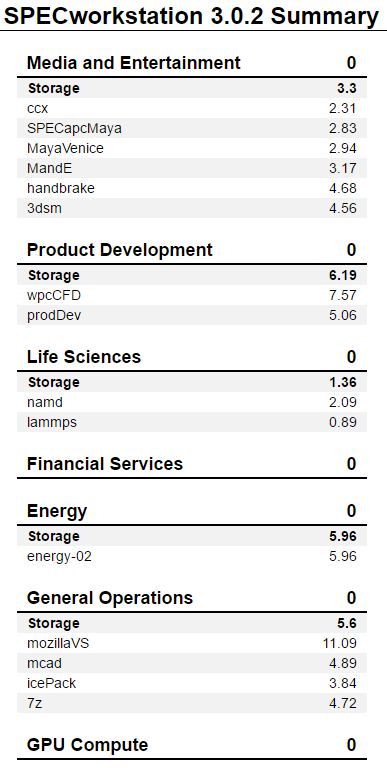
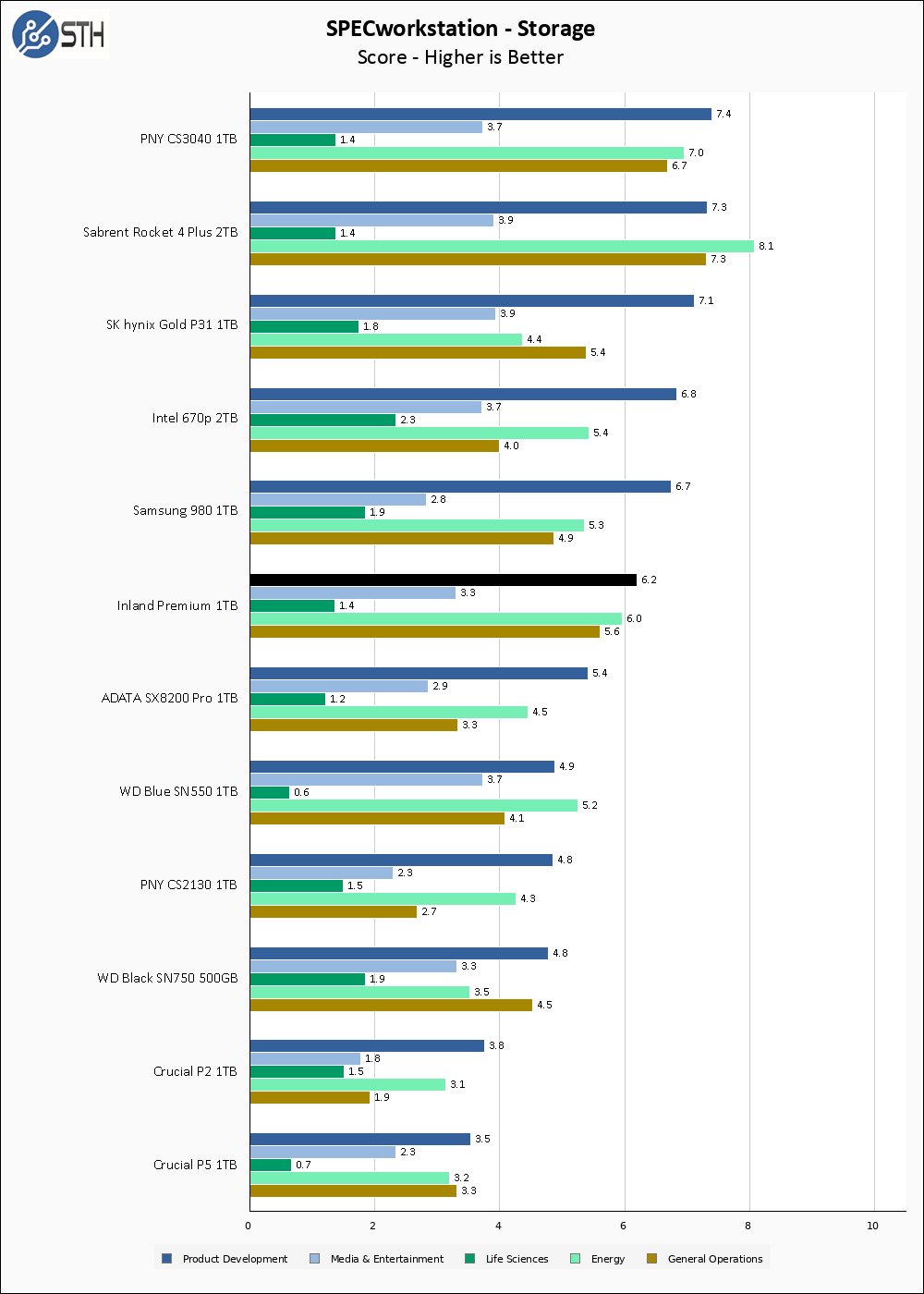
SPECworkstation performance for the Inland Premium 1TB is a bit of a mixed bag. Product Development and Media performance lands it in the middle of our chart, and Life Sciences is on the lower end of things. On the other hand, the Energy and General Operations sub-scores are very good on this drive.
Sustained Write Performance
This is not necessarily a benchmark, so much as trying to catch the post-cache write speed of the drive. While I am filling the drive with data to the 85% mark with 10 simultaneous write threads, I monitor the drive for the write performance to dip to the lowest steady point and grab a screenshot.
This is a new section to my reviews, and something I plan to track from now on. Since I have not been gathering this data up until recently, I do not have historical data from many of my other reviews. This is the first review where I will have a comparison chart, though it is still a bit barren compared to the rest of my results database.
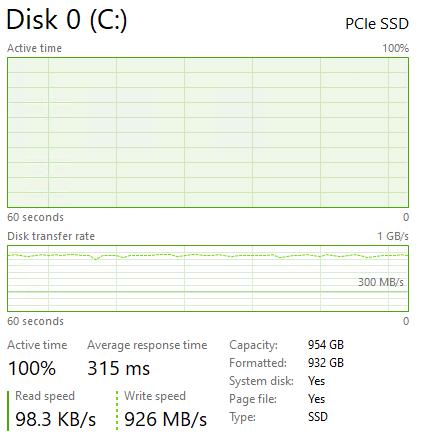
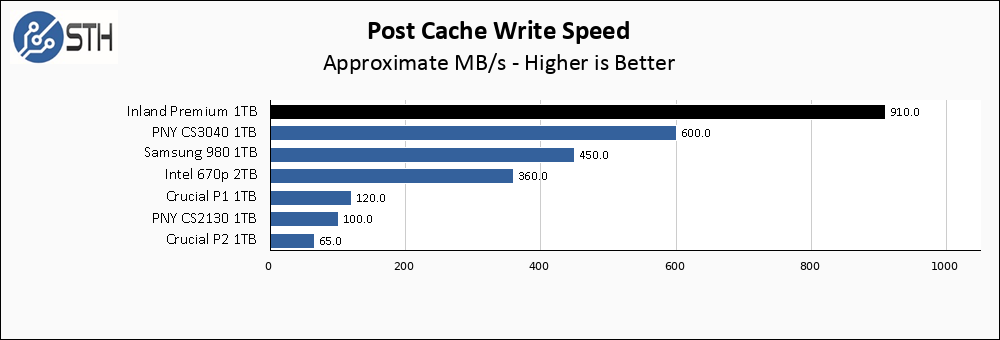
Coming in at a sustained post-cache write speed north of 900 MB/s, the Inland Premium 1TB is an absolutely excellent performer in this test, besting the sustained write performance of much more expensive SSDs.
Benchmark Comparisons
We are going to directly compare the Inland Premium 1TB against two more modern 1TB SSDs in the Samsung 980 1TB and the SK hynix Gold P31 1TB. These two were chosen because the performance of the Inland drive warranted the comparison some of the best PCIe 3.0 SSDs in my results database.
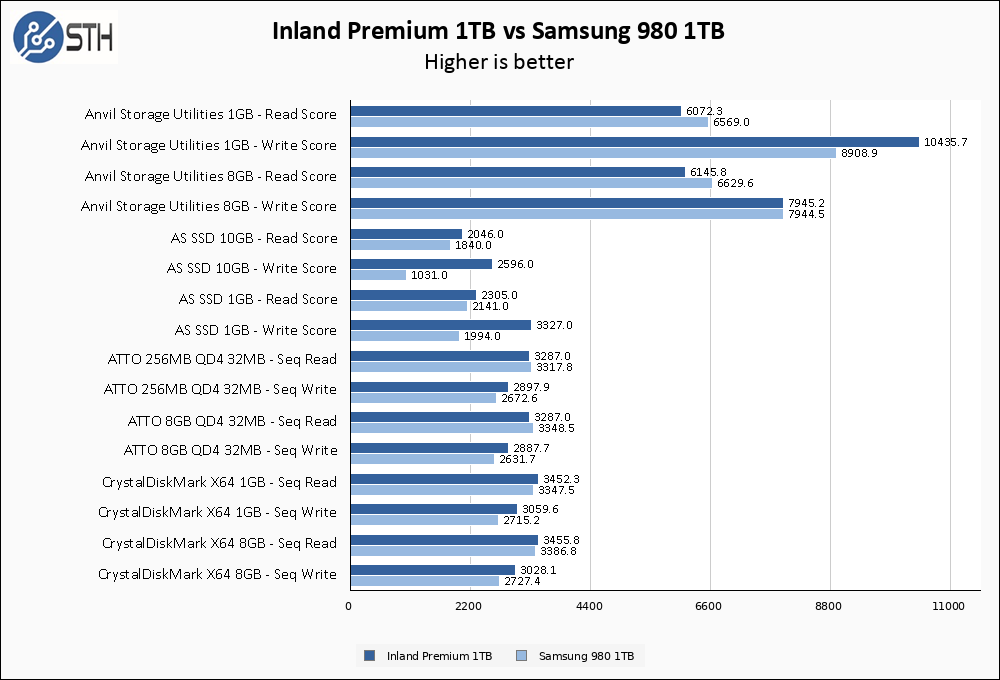
In general, performance between these two drives is similar, but the Inland Premium 1TB wins far more often than it loses. Often those wins are essentially within the margin of error for testing, but sometimes they are not as evidenced by the AS SSD write tests. Considering the Samsung 980 is more expensive, the Inland drive makes a great showing.
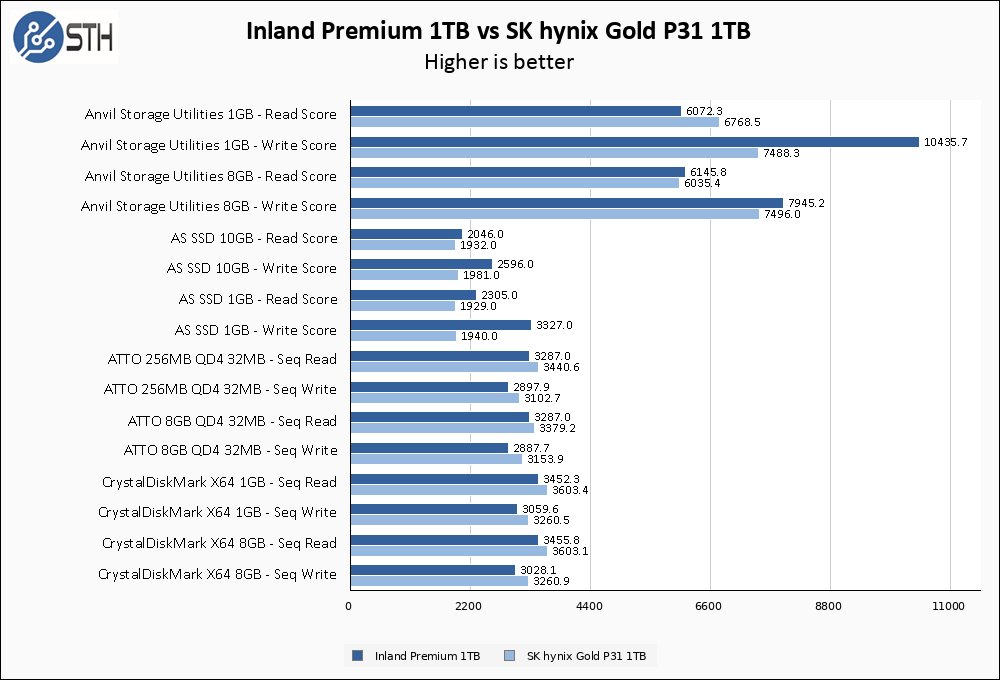
The SK hynix Gold P31 is essentially my personal favorite PCIe 3.0 1TB SSD and happens to be the drive in my personal PC. Compared to the Inland Premium 1TB, the two drives trade blows, with neither drive significantly outperforming the other. The fact of the matter is that the Inland drive is a solid performer, and keeps up with the best of the PCIe 3.0 SSDs on the market.
Temperatures
We monitored the idle and maximum temperature during testing with HWMonitor to get some idea of the thermal performance and requirements of the drive. Please keep in mind that our test bench is an open frame chassis in a 22C room, but with no direct airflow. As a result, this is not representative of a cramped low airflow case and is instead intended to model temperatures of a drive ‘on its own’.

The Inland Premium 1TB can run hot. This is pretty common for TLC-based Phison E12 drives and is the sole area where the SK hynix Gold P31 can hold dominion over almost all other PCIe 3.0 SSDs. With that said, outside of benchmark conditions it is unlikely the temperatures will be much of a problem and any heatsink or active airflow should be able to keep the drive cool.
Again, we are mostly looking for the absence of runaway thermals here during our testing rather than comparing drives to each other.
Final Words
The Inland Premium 1TB is $113 at Microcenter and $118 on Amazon. At the same time, the performance of this drive is much more in line with $130+ drives like the Samsung 980 1TB and the SK hynix Gold P31 1TB. In terms of price to performance, it is hard to argue with the Inland Premium 1TB.

Essentially the only knock I have against this drive in the entire review is the 3-year warranty. The $130+ performance peers from Samsung and SK hynix come with 5-year warranties, albeit their rated endurance numbers are both significantly lower than the Inland drive. Most users will hit the length of the warranty before they reach the endurance rating on the drive, and doubly so if you are only looking at a 3-year warranty.
For me, what it comes down to is this; if you need a 5-year warranty and have a few extra dollars to spare, you can look at a drive like the SK hynix Gold P31. If you are comfortable with a 3-year warranty on a SSD at this price point, the Inland Premium 1TB is an undeniable performer and makes for a great option. Personally, I find myself in the second camp, and will happily recommend this drive to friends in the future.




If it proves reliable, then it will get the nod over Samsungs in my builds! Excellent pricing!
I really appreciate the sustained write performance metric. Too many reviews don’t even saturate the cache.
From having dealt with microcenter on inland (and confirmed by employee helping) all inland products warranties are handled instore if actually purchased there and not a reseller
Thanks Larry. One of the interesting aspects is that we purchased this drive on Amazon.
Post cache writes are important. Thank-you for measuring it.
I’d love to know how consistent the hardware underneath the sticker is. If all the drives with “inland Premium 1TB NVMe SSD” on the package perform like this one it’s a killer deal(with the possible exception of thermally constrained laptop/USFF scenarios, it looks like it’s a little toasty for that; but nothing that would cause trouble in a higher airflow environment.)
If the same sticker goes on 5 different drives from whatever ODM was cheapest to rebadge that day and there’s no way of knowing which one you are getting that’s less exciting.
Surprise flash/controller/firmware swaps can (and have) happened even with considerably more expensive hardware from better known brands(some of which are shamefully unwilling to be nailed down on anything aside from capacity and a couple of unverifiably vague performance numbers); so I’m not just suspicious of inland because it’s a store brand (I’ve generally gotten solid results from them in the past); but if there is enough variation that I can’t just walk into Microcenter and grab a handful of these without potentially getting some drives that vary considerably that is a bit of a downer.
Awesome decision to include a non-mainstream brand! Thank You!
Every time one of these article/reviews of the NVMEs comes out, I keep on praying you retro-actively add some of the early drives to the Sustained Write Performance chart.
If I could choose one, PLEASE ADD the SK HYNIX P31 to the post-cache chart! pretty please!
Microcenter (IIRC) owns in part or all of the label Inland and sells via Amazon. I have a 2GB and 2 1GB versions of this drive, they punch above their weight class for the price.
@fuzzyfuzzyfungus
My experience is of course anecdotal, but fwiw, I have purchases the 2TB model (early 2019 iirc), the 256GB model, and the 512GB model (both pre-pandemic 2020). They are all Phison e12 with Toshiba BiCS (with DRAM caches). Considering this review notes the same, I would say they have been pretty consistent for at least several years. That is of course not necessarily indicitive of the future though…
Also anecdotally, I have experienced no issues with any of them to date.
Random note though, Do not mix up the Inland Premium and Inland Pro/Professional. The pro line is dram-less and not very good. The “Premium” branded model is the good one!
A MicroCenter employee once told me they choose Inland Premium NVMe SSDs for all of their display models because they’ve had the greatest balance of reliability/price among their NVMe choices.
I use dozens of Inland’s in the field for our appliances and they are rock solid stable, fast and I have not had a single one fail. I am still amazed how good these are for the price.
What is the difference between the Platinum and the Premium version? I can’t find the 1TB Premium SATA sticks anywhere.
Thanks
Will, please recheck your facts. As of this writing 3/8/22, Microcenter warrantee it’s Inland SSD’s for six years. Also, the IPSG Products web site is owned and copywrite by Micro Center so I would think any warrantee issues would be handled by Micro Center. Personally, I have two ITB Micro Center dives one in a desk top and one in an external enclosure and both have performed flawlessly for over two years. I will have no compunction buying another.